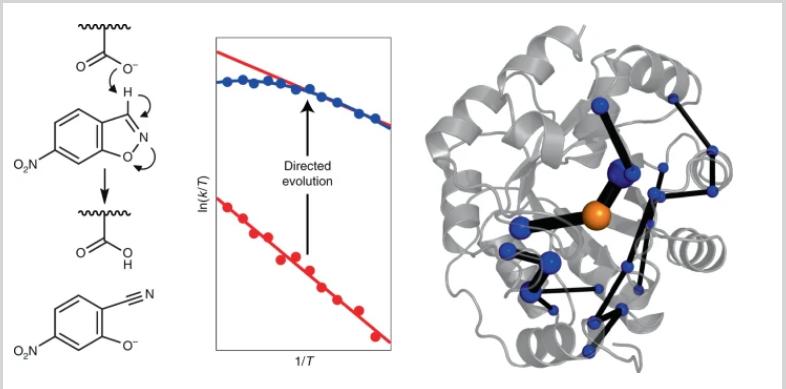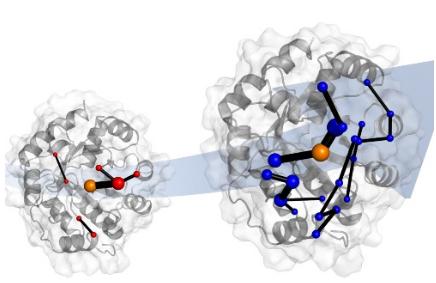博文
了解酶的进化为“绿色”化学铺平了道路
 精选
精选
||
了解酶的进化为“绿色”化学铺平了道路
诸平


Laboratory evolution of a designer enzyme makes it into a much better catalyst . Simulations show that evolution does this by introducing networks of amino acids. These networks promise to be templates for catalyst design. Credit: Dr. Adrian Bunzel
据英国布里斯托大学(University of Bristol)2021年8月19日提供的消息,该校的研究人员已经展示了实验室进化如何产生用于新自然反应的高效酶,为制造药物和其他化学品的新方法和更环保的方法打开了大门。相关研究结果于2021年8月19日已经在《自然化学》(Nature Chemistry)杂志网站发表——H. Adrian Bunzel, J. L. Ross Anderson, Donald Hilvert, Vickery L. Arcus, Marc W. van der Kamp, Adrian J. Mulholland. Evolution of dynamical networks enhances catalysis in a designer enzyme. Nature Chemistry, Published: 19 August 2021; DOI: 10.1038/s41557-021-00763-6. www.nature.com/articles/s41557-021-00763-6
科学家们以前曾使用计算机从头开始设计蛋白质催化剂,但这些催化剂的能力远不如天然酶。为了提高它们的性能,可以使用一种称为实验室进化(laboratory evolution)的技术,该技术是美国化学工程师弗朗西斯·阿诺德 (Frances Arnold) 首创的,并因此获得了2018年的诺贝尔化学奖(The Nobel Prize in Chemistry 2018,Frances H. Arnold;George P. Smith;Sir Gregory P. Winter)。模仿自然选择进行定向进化,使科学家能够利用生物学的力量来提高蛋白质来执行任务的能力,例如催化特定的化学反应。但是,尽管研究小组最近使用实验室进化将设计的酶提高了1000倍以上,但直到现在为止,尚不清楚进化如何提高其活性。
上述论文的通讯作者布里斯托尔大学化学学院(Bristol's School of Chemistry)的阿德里安·马尔霍兰(Adrian Mulholland)教授说:“进化可以使催化剂更加活跃。问题是,进化以神秘的方式起作用:例如,明显改善催化作用的突变通常涉及远离活性位点的氨基酸的变化反应发生的地方。”
“我们想了解进化如何将设计的低效生物催化剂转化为高活性酶。”该研究的第一作者阿德里安·邦泽尔(Adrian Bunzel)博士说。
为此,来自英国布里斯托尔大学、瑞士苏黎世联邦理工学院(ETH Zurich)和新西兰的怀卡托大学(University of Waikato, NZ)的国际研究团队转向了分子计算机模拟。“这些表明进化改变了蛋白质的运动方式——它的动力学。简而言之,进化‘调整’了整个蛋白质的灵活性,”阿德里安·邦泽尔博士补充道。
该团队还确定了负责这种“调整”的蛋白质中的氨基酸网络(network of amino acids)。这些网络涉及因进化而改变的蛋白质部分。
A阿德里安·邦泽尔博士说:“进化后,整个蛋白质似乎共同作用以加速反应。这很重要,因为当我们设计酶时,我们通常只关注活性位点( active site),而忽略了蛋白质的其余部分。”
阿德里安·马尔霍兰教授补充说:“这种分析有助于设计更有效的‘从头合成’酶('de novo' enzymes),用于以前我们无法针对的反应。”
发表在《自然化学》杂志网站上研究结果,揭示了进化如何使设计酶变得更强大,为定制绿色化学催化剂铺平了道路。研究人员现在将利用他们的发现来帮助设计新的蛋白质催化剂(protein catalysts)。上述介绍,仅供参考。欲了解更多信息敬请注意浏览原文或者相关报道。
Activation heat capacity is emerging as a crucial factor in enzyme thermoadaptation, as shown by the non-Arrhenius behaviour of many natural enzymes. However, its physical origin and relationship to the evolution of catalytic activity remain uncertain. Here we show that directed evolution of a computationally designed Kemp eliminase reshapes protein dynamics, which gives rise to an activation heat capacity absent in the original design. These changes buttress transition-state stabilization. Extensive molecular dynamics simulations show that evolution results in the closure of solvent-exposed loops and a better packing of the active site. Remarkably, this gives rise to a correlated dynamical network that involves the transition state and large parts of the protein. This network tightens the transition-state ensemble, which induces a negative activation heat capacity and non-linearity in the activity–temperature dependence. Our results have implications for understanding enzyme evolution and suggest that selectively targeting the conformational dynamics of the transition-state ensemble by design and evolution will expedite the creation of novel enzymes.
https://blog.sciencenet.cn/blog-212210-1300657.html
上一篇:研究揭示了饮食中的果糖是如何导致肥胖的
下一篇:在实验室培养更复杂和成熟的心脏组织